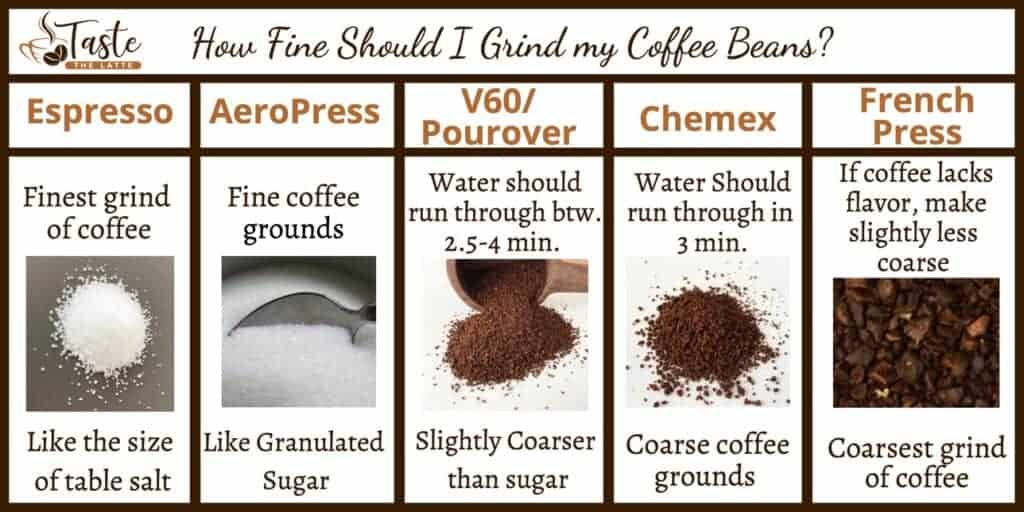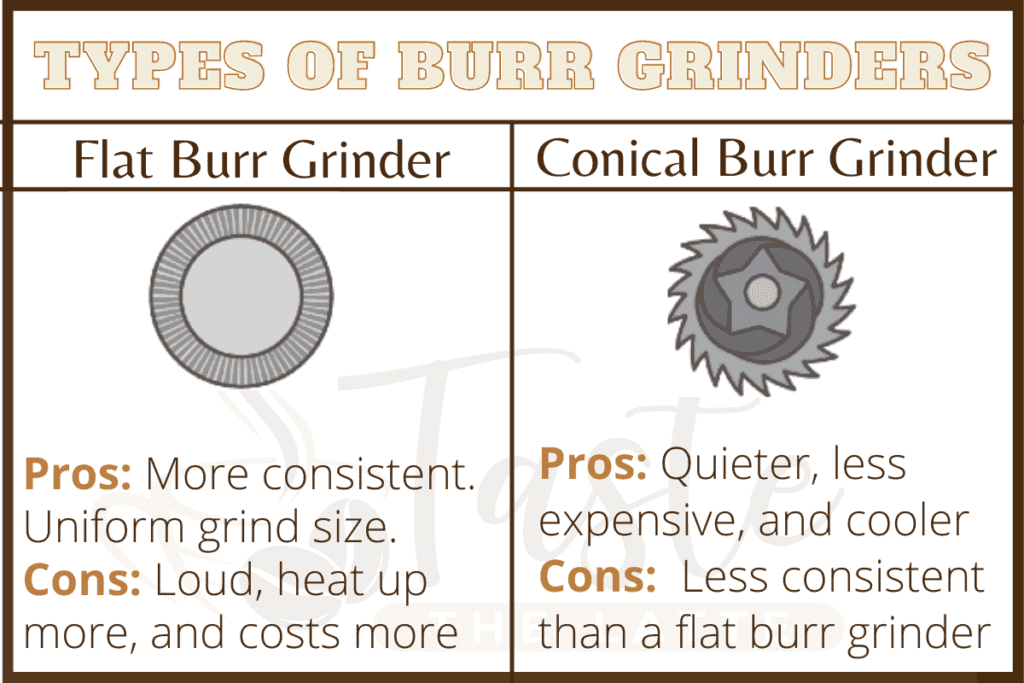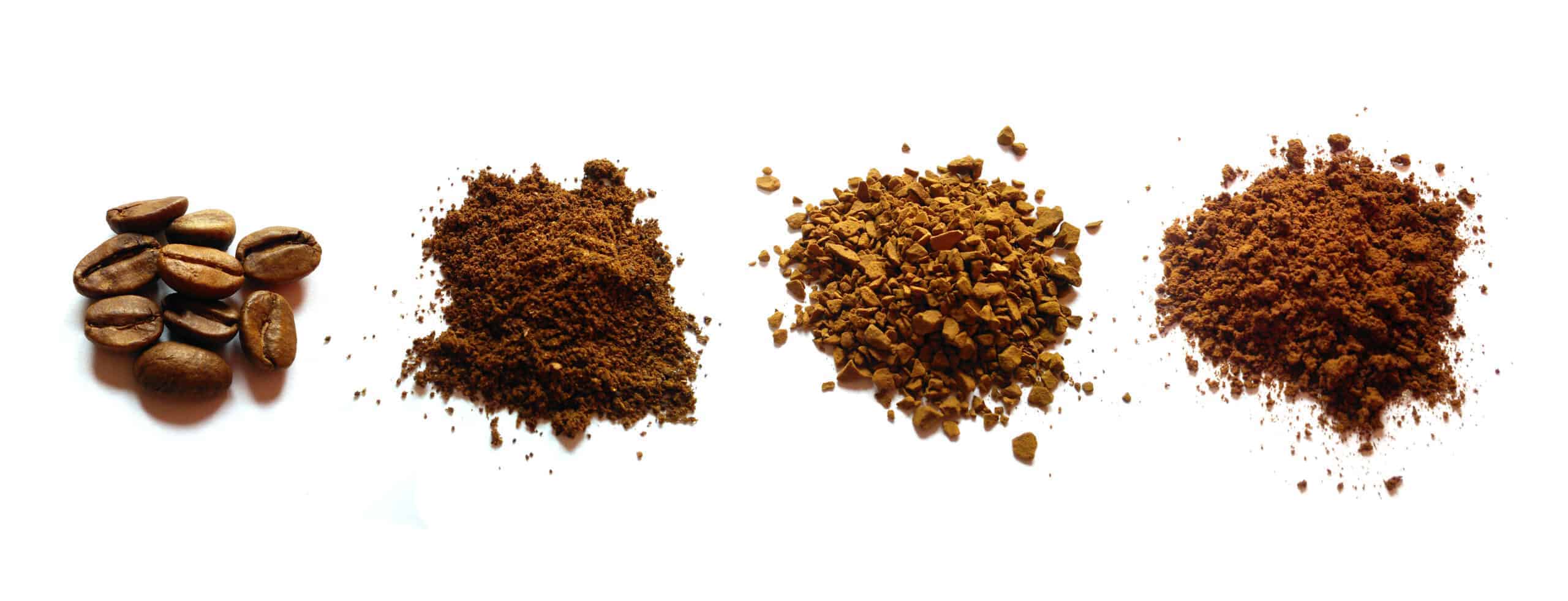I always recommend buying whole coffee beans and grinding them fresh. By doing this, you can guarantee a much tastier cup of coffee. But how do you know how fine to grind your coffee beans?
How fine should I grind my coffee beans? Determining the right grind size depends on two things: what brew method your using and the amount of coffee you are brewing.
There is so much more to get into regarding grind size, different brewing methods, and how it can affect the taste of your cup of coffee.
Different Grind Size for Different Brew Methods
Coffee grind is mostly determined by the brew device you are using. There are a variety of different ways to brew coffee, each warranting a specific grind size. And yes, grind size matter.
Take a look at the table below for a quick reference and then we’ll dig deeper into each one.

Check out our other article, “What is the best way to grind coffee beans?”
Coffee Grind Size for an Espresso?
Espresso requires the finest grind of coffee. This is because it requires a large amount of ground coffee compared to the small amount of liquid in an espresso. The contact time between the coffee and the water is also the shortest (usually around 30 seconds) in espresso.
So, the greater the surface area of the coffee (the finer the grind), the more delicious flavors we can extract from the coffee in that time. All espresso machines will require slightly different grinds for espresso because they will have somewhat different pressures.
However, you are looking for a grind which like the coarseness of table salt. If you use an extra fine grind, more like a powder, the espresso will run out too slowly and will cause over-extraction.
Similarly, if you grind too coarsely, the water will run straight through the coffee too quickly, and you get little flavor from it (and probably no crema). Getting the grind right for espresso usually takes a couple of tries, so if your espresso doesn’t turn out perfectly the first time, adjust the grind finer to make the espresso run slower, or coarser to make the espresso run faster.
Coffee shops will spend around 15 minutes every morning pulling espressos until they are running just how they would like them to (this is called dialing in). Then they will continue to adjust throughout the day to keep the espresso running just as they require it. So if your espresso doesn’t run through as you would like it to the first time, adjust the grind and persevere. This is entirely normal.
Note: Turkish coffee is also made with a fine grind size.
Grind Setting for AeroPress Coffee Makers?
The setting for Aeropress is a medium-fine grind size or a little coarser than the grind setting for espresso. Whereas I suggested starting with a salt-like fineness for espresso, I go for a grind more like granulated sugar or sand with an AeroPress.
The reason for a coarser grind is the water has more contact time with the coffee (between 2.5 minutes and 3.5 minutes, dependent on your Aeropress method). However, you do not want the coffee so coarse that there is little resistance when pushing down the Aeropress.
If you’re using an Aeropress for a single cup of coffee (around 15g of coffee), you will want the grind to remain quite fine. If making two cups of coffee with your Aeropress by making a short intense coffee in the Aeropress then adding hot water to dilute, you will require a slightly coarser grind. This is because there will be more coffee (around 30g for two cups) for the water to go through.
If the grind is too fine, you will find it difficult to plunge the Aeropress. If this happens, adjust your grind to be a little coarser so you can comfortably (but not quickly, it should take around 20 – 30 seconds) plunge the Aeropress.
Grind Size for a Pour-over/ V60?
Unlike brewing espresso or an Aeropress, when brewing a V60, there is no external pressure to push the water through the coffee. So the grind’s coarseness is set so that the water can run through the coffee and into the cup in your allotted brew time (usually between 2.5 minutes and 4 minutes).
If you are brewing a single cup of coffee with your V60 (for example, 16g of coffee to 250g of water), you will want a medium grind, slightly more coarse than granulated sugar. This should be fine enough to allow the water to run through in less than 4 minutes, but not so coarse that it runs through in less than 2.5 minutes.
Again, if you find your water is running through too fast, grind a little finer next time, and if you find it’s running too slow, grind a little coarser. Suppose you are brewing a V60 for two cups of coffee. In that case, you will be putting double the amount of water through double the amount of coffee.
As a result, there will be much more resistance. To ensure it doesn’t take too long for the water to go through the coffee, you will require a more coarse grind for a two-cup brew than you would for a single cup.
How Fine Should You Grind Coffee for a Chemex?
A Chemex calls for a medium-coarse grind. Brewing a Chemex is very similar to brewing a V60. The same principles apply in that there is no external pressure like in an Aeropress or espresso; you are just looking for the water to run through the bed of coffee and filter paper in your allotted brew time (usually between 2.5 and 4 minutes).
The difference between a Chemex and a V60 is typically the amount of coffee you are brewing. Mostly if you are brewing a Chemex, you will be brewing between 4 and 6 cups of coffee. Because of this, you will require a significantly more coarse coffee grind than if you were brewing just a single cup.
To grind coffee to the right fineness for a 4 – 6 cup Chemex, I recommend taking your grinder to its most coarse setting and dialing it back a few notches. At the grinder’s coarsest setting, the water will run through the coffee too quickly, so it’s a case of dialing it back to get the sweet spot of the coffee running through in around 3 minutes.
How Fine Should You Grind Coffee for an French Press?
Grinding for a French Press (or cafetiere) is more straightforward than grinding for any other method discussed in this blog. The coffee is continually submerged in water when brewing a French Press, so it has the greatest contact time.
Therefore, you can use a coarser grind, like the size of sea salt, for a French Press than any other brew method. When I brew a French Press, I grind my coffee in the coarsest setting.
You know the grind is too coarse if my coffee lacks flavor or tastes grassy. If the grind is too fine, you will find coffee silt in the bottom of your cup or find the French Press difficult to plunge. If either of these things occurs, adjust the grind accordingly – finer if the coffee lacks flavor and coarser if it’s thick or hard to plunge.
Related Reading: What Kind of Coffee is Best for a French Press?
How Fine Should You Grind Coffee for a Moka Pot?
The stovetop espresso maker, the Moka Pot typically calls for a medium-fine coffee grind, or approximately the size of table salt. Again, everyone is going to have different preferences, so take this as a starting place and adjust.
Grind Setting for Cowboy Coffee?
Cowboy coffee isn’t a brewing device but requires a specific grind size. An extra coarse grind is necessary. To learn what cowboy coffee is and how to make it, click here.
Grind Setting for a Cold Brew?
Cold brew coffee is brewed cold to create a smoother finished cup of coffee. It requires a coarse grind. To learn how to make a cold brew at home, click here.
Is Grind Size Dependent on How Much Coffee You’re Brewing?
How much coffee you are brewing will also affect how fine or coarse you want your coffee grounded.
For example, if you’re brewing a single cup of coffee in a V60, you will want a finer grind than if you were brewing two cups of coffee in that same V60. Let’s dive a little deeper into each brewing method and how you should grind your coffee beans for that particular brewer.
Below is a quick guide to follow when grinding coffee grounds, but be sure to continue reading to truly understand the proper fineness/coarseness of coffee grounds you will need.
What is the Right Way to Grind Coffee Beans?
The best and easiest way to grind whole bean coffee is with a coffee grinder. Two types of grinders are blade and burr grinders. Each has a different method for grinding, but one is far superior over the other.
Blade Coffee Grinder: Blade grinders have blades that spin to slice the beans repeatedly, similar to a blender. The grind size cannot be preset and is only determined by how long the grinder is turned on. A coarse grind is made by shortening the grind time and using short bursts. A fine grind is made by lengthening the time the grinder is on. A consistent grind is difficult to obtain with a blade grinder.
Burr Coffee Grinder: Burr grinders have metal pieces with ridged or roughened edges, called burrs. Instead of being the beans being sliced, they are ground. To change the grind size, you open the burrs up and move them closer together or farther apart. Burr grinders offer more control, more consistency, and a more uniform grind.
There are two types of burr grinders: conical or flat burrs. Flat burr grinders are more consistent than blade grinders, but the burrs rotate the same way as a blade grinder. This type of burr grinder is less expensive but might make noise when running.
Conical burr grinders are the better of the two types but are among the most expensive coffee grinders. The slower burr spinning speed reduces messes, not to mention unwanted noise.
To read more about the best way to grind your coffee beans, click here.

What Happens if you Grind Coffee too Fine?
If your coffee is ground too fine, it can lead to over-extraction. Over-extraction occurs when too many soluble flavors are taken from the coffee beans and put into your cup. When the beans’ flavor is extracted too long, you will experience an unpleasant taste.
An over-extracted cup of coffee can produce some harsher flavors, such as burnt, bitter, and metallic.
What Happens if you Grind Coffee too Coarse?
If your coffee is ground too coarse, it can lead to under-extraction. Under-extraction is when the coffee grounds are not given enough time to brew completely. As a result, not all of the beans’ oils, sugars, and wonderful flavors get a chance to be extracted and are still left in the grounds.
A under-extracted cup of coffee can lead to coffee tasting sour, salty, or soapy.

Our Suggestion for the best Coffee Grinders
Final Thoughts
Finding the perfect grind size for your brew method is not only a science but also dependent on personal preference. Experimenting with different methods and different coarseness/fineness of your coffee grind is what being a true coffee enthusiast is all about!


